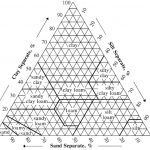The USDA classifies soil types according to a soil texture triangle chart which gives names to various combinations of clay, sand, and silt. The Soil Triangle is a commonly used visual representation of the possible soil type combinations based on soil particle size. Larger particles will have less surface area per volume of soil. This difference in the amount of surface area has two major effects on the physical properties of soils:
a) those soils composed mainly of larger particles (sand) will have more open space (porosity) and will interact less (permeability) with water, air, and nutrients in the soil as compared to soils composed of smaller particles such as clay or silt.
and
b) soils composed mainly of larger particles (sand) will have less electrical charges, making them unable to attract and hold water and nutrients as well as a clay or silt soil.
These are basic and important properties for growers to understand – they directly affect both the quantity and frequency of fertilizer applications best suited for crop growth.
How to Use the Soil Triangle
- Look at the orientation of the percentages on the sides of the triangle. The numbers are arranged symmetrically around the perimeter. On the left the numbers correspond to the percentage of clay, and on the right the numbers correspond to the percentage of silt. At the bottom of the triangle chart are the percentages of sand.
- To classify a soil sample, you find the intersection of the three lines that correspond the three proportions. At each position on the chart, all of the percents will add up to 100%.

